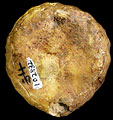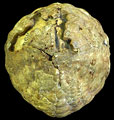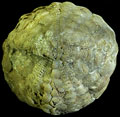The Echinoid Directory
Stenonaster Lambert, 1922, p. 114
[pro Stenonia Desor, 1858, p. 333 (non Gray, 1853); pro Stenocorys Lambert & Thiery, 1917, p. 3 (non Burmeister, 1835)]
| Diagnostic Features |
|
|---|---|
| Distribution | Upper Cretaceous (Scaglia, Senonian undifferentiated), Italy, Iran. |
| Name gender | masculine |
| Type | Ananchytes tuberculatus Defrance, 1816, p. 41, by original designation. |
| Species Included | Lambert & Thiery (1921, p. 426) list a second species S. morgani Gauthier from the Senonian of Iran. |
| Classification and/or Status | Irregularia; Atelostomata incertae sedis Presumed monophyletic |
| Remarks | A very puzzling taxon on account of its compact ethmophract apical disc but primitive, meridosternous plastron. Closely related to Menuthiaster but differing from that taxon in having a flat base with the periproct much lower, no trace of a peripetalous fasciole and rather domed aboral plates. |




